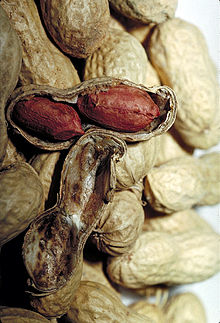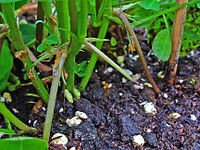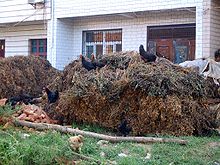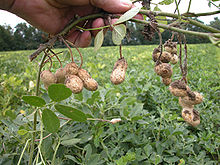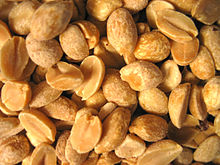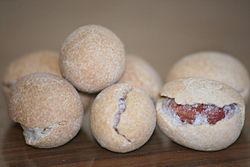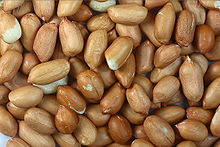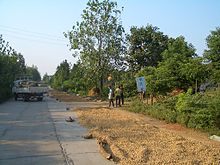- Peanut
-
Peanut 
Scientific classification Kingdom: Plantae (unranked): Angiosperms (unranked): Eudicots (unranked): Rosids Order: Fabales Family: Fabaceae Subfamily: Faboideae Tribe: Aeschynomeneae Genus: Arachis Species: A. hypogaea Binomial name Arachis hypogaea
L.The peanut, or groundnut (Arachis hypogaea), is a species in the legume or "bean" family (Fabaceae). The peanut was probably first cultivated in the valleys of Peru.[1] It is an annual herbaceous plant growing 30 to 50 cm (1.0 to 1.6 ft) tall. The leaves are opposite, pinnate with four leaflets (two opposite pairs; no terminal leaflet), each leaflet 1 to 7 cm (⅜ to 2¾ in) long and 1 to 3 cm (⅜ to 1 inch) broad.
The flowers are a typical peaflower in shape, 2 to 4 cm (0.8 to 1.6 in) (¾ to 1½ in) across, yellow with reddish veining. Hypogaea means "under the earth", after pollination, the flower stalk elongates causing it to bend until the ovary touches the ground. Continued stalk growth then pushes the ovary underground where the mature fruit develops into a legume pod, the peanut – a classical example of geocarpy. Pods are 3 to 7 cm (1.2 to 2.8 in) long, containing 1 to 4 seeds.[2]
Peanuts are known by many other local names such as earthnuts, ground nuts, goober peas, monkey nuts, pygmy nuts and pig nuts.[3][4][5]
Contents
History
The domesticated peanut is an amphidiploid or allotetraploid, meaning that it has two sets of chromosomes from two different species, thought to be A. duranensis and A. ipaensis. These likely combined in the wild to form the tetraploid species A. monticola, which gave rise to the domesticated peanut.[6] This domestication might have taken place in Paraguay or Bolivia, where the wildest strains grow today. Many pre-Columbian cultures, such as the Moche, depicted peanuts in their art.[7]
Archeologists have dated the oldest specimens to about 7,600 years, found in Peru.[8] Cultivation spread as far as Mesoamerica where the Spanish conquistadors found the tlalcacahuatl (Nahuatl = 'peanut,' whence Mexican Spanish, cacahuate and French, cacahuète) being offered for sale in the marketplace of Tenochtitlan (Mexico City). The plant was later spread worldwide by European traders.
Cultivation
The orange-veined, yellow-petaled, pea-like flower of the Arachis hypogaea is borne in axillary clusters above ground.[citation needed] Following self-pollination, the flowers fade and wither. The stalk at the base of the ovary, called the pedicel, elongates rapidly, and turns downward to bury the fruits several inches in the ground, where they complete their development. The entire plant, including most of the roots, is removed from the soil during harvesting.[9] The fruits have wrinkled shells that are constricted between pairs of the one to four (usually two) seeds per pod.
Peanuts grow best in light, sandy loam soil. They require five months of warm weather, and an annual rainfall of 500 to 1,000 mm (20 to 39 in) or the equivalent in irrigation water.[10]
The pods ripen 120 to 150 days after the seeds are planted. If the crop is harvested too early, the pods will be unripe. If they are harvested late, the pods will snap off at the stalk, and will remain in the soil.[9]
Peanuts are particularly susceptible to contamination during growth and storage. Poor storage of peanuts can lead to an infection by the mold fungus Aspergillus flavus, releasing the toxic and highly carcinogenic substance aflatoxin. The aflatoxin-producing molds exist throughout the peanut growing areas and may produce aflatoxin in peanuts when conditions are favorable to fungal growth.
Harvesting occurs in two stages.[citation needed] In mechanized systems, a machine is used to cut off the main root of the peanut plant by cutting through the soil just below the level of the peanut pods. The machine lifts the "bush" from the ground and shakes it, then inverts the bush, leaving the plant upside down on the ground to keep the peanuts out of the soil. This allows the peanuts to dry slowly to a bit less than a third of their original moisture level over a period of three to four days. Traditionally, peanuts are pulled and inverted by hand.
After the peanuts have dried sufficiently, they are threshed, removing the peanut pods from the rest of the bush.[9]
Cultivation in China
The peanut was introduced to China by Portuguese traders in the 17th century and another variety by American missionaries in the 19th century.[citation needed]
They became popular and are featured in many Chinese dishes, often being boiled. During the 1980s, peanut production began to increase so greatly that as of 2006, China was the world's largest peanut producer. A major factor in this increase was the household-responsibility system, which moved financial control from the government to the farmers.[11][12]
Production
China leads in production of peanuts, having a share of about 41.5% of overall world production, followed by India (18.2%) and the United States of America (6.8%).
Top ten producers of peanuts in 2008/2009 Country Production (Million Metric Tons)
 People's Republic of China
People's Republic of China14.30  India
India6.25  United States
United States2.34  Nigeria
Nigeria1.55  Indonesia
Indonesia1.25  Myanmar
Myanmar1.00  Sudan
Sudan0.85  Senegal
Senegal0.71  Argentina
Argentina0.58  Vietnam
Vietnam0.50 World 34.43 Source: USDA Foreign Agricultural Service: Table 13 Peanut Area, Yield, and Production
Cultivars
Thousands of peanut cultivars are grown, with four major cultivar groups being the most popular: Spanish, Runner, Virginia, and Valencia. There are also Tennessee red and white groups.[citation needed] Certain cultivar groups are preferred for particular uses because of differences in flavor, oil content, size, shape, and disease resistance. For many uses the different cultivars are interchangeable. Most peanuts marketed in the shell are of the Virginia type, along with some Valencias selected for large size and the attractive appearance of the shell. Spanish peanuts are used mostly for peanut candy, salted nuts, and peanut butter. Most Runners are used to make peanut butter.
The various types are distinguished by branching habit and branch length. There are numerous varieties of each type of peanut. There are two main growth forms, bunch and runner. Bunch types grow upright, while runner types grow near the ground.
Each year new cultivars of peanuts are bred and introduced. Introducing a new cultivar may mean change in the planting rate, adjusting the planter, harvester, dryer, cleaner, sheller, and method of marketing.
Spanish group
The small Spanish types are grown in South Africa, and in the southwestern and southeastern U.S. Prior to 1940, 90% of the peanuts grown in Georgia, USA were Spanish types, but the trend since then has been larger-seeded, higher-yielding, more disease-resistant cultivars. Spanish peanuts have a higher oil content than other types of peanuts and in the U.S. are now primarily grown in New Mexico, Oklahoma, and Texas.
Cultivars of the Spanish group include "Dixie Spanish", "Improved Spanish 2B", "GFA Spanish", "Argentine", "Spantex", "Spanette", "Shaffers Spanish", "Natal Common (Spanish)", "White Kernel Varieties", "Starr", "Comet", "Florispan", "Spanhoma", "Spancross", "OLin", "Tamspan 90", "AT 9899-14", "Spanco" "Wilco I", "GG 2", "GG 4" , "TMV 2", and "Tamnut 06".
Runner group
Since 1940, the southeastern U.S. region has seen a shift to production of Runner group peanuts. This shift is due to good flavor, better roasting characteristics and higher yields when compared to Spanish types leading to food manufacturers' preference for the use in peanut butter and salted nuts. Georgia's production is now almost 100% Runner type.[citation needed]
Cultivars of Runners include "Southeastern Runner 56-15", "Dixie Runner", "Early Runner", "Virginia Bunch 67", "Bradford Runner", "Egyptian Giant" (also known as "Virginia Bunch" and "Giant"), "Rhodesian Spanish Bunch" (Valencia and Virginia Bunch), "North Carolina Runner 56-15", "Florunner", "Virugard", "Georgia Green", "Tamrun 96", "Flavor Runner 458", "Tamrun OL01", "Tamrun OL02" "AT-120", "Andru-93", "Southern Runner", "AT1-1", "Georgia Brown", "GK-7",and "AT-108".
Virginia group
The large seeded Virginia Group peanuts are grown in the following US states: Virginia, North Carolina, Tennessee, Texas, New Mexico, Oklahoma, and parts of Georgia. They are increasing in popularity due to demand for large peanuts for processing, particularly for salting, confections, and roasting in the shells.
Virginia Group peanuts are either bunch or running in growth habit. The bunch type is upright to spreading. It attains a height of 45 to 55 cm (18 to 22 in), and a spread of 70 to 80 cm (28 to 31 in), with 80 to 90 cm (31 to 35 in) rows that seldom cover the ground. The pods are borne within 5 to 10 cm of the base of the plant.
Cultivars of Virginia type peanuts include NC 7, NC 9, NC 10C, NC-V 11, VA 93B, NC 12C, VA-C 92R, Gregory, VA 98R, Perry, Wilson, Hull, AT VC-2 and Shulamit.
Valencia group
Valencia Group peanuts are coarse, and they have heavy reddish stems and large foliage. In the U.S., large commercial production is primarily in the south plains of west Texas and eastern New Mexico near and south of Portales, New Mexico, but they are grown on a small scale elsewhere in the South as the best flavored and preferred type for boiled peanuts. They are comparatively tall, having a height of 125 cm (49 in) and a spread of 75 cm (30 in). Peanut pods are borne on pegs arising from the main stem and the side branches. Most of the pods are clustered around the base of the plant, and only a few are found several inches away. Valencia types are three to five seeded and smooth, with no constriction of the shell between the seeds. Seeds are oval and tightly crowded into the pods. Typical seed weight is 0.4 to 0.5 g. This type is used heavily for sale roasted and salted in-shell peanuts and peanut butter. Varieties include Valencia A and Valencia C.
Tennessee Red and Tennessee White groups
These are alike, except for the color of the seed. Sometimes known also as Texas Red or White, the plants are similar to Valencia types, except that the stems are green to greenish brown, and the pods are rough, irregular, and have a smaller proportion of kernels.
Uses
Varied applications
Peanuts have many uses. They can be eaten raw, used in recipes, made into solvents and oils, used in make-up, medicines, textile materials, peanut butter, as well as many other uses. Popular confections made from peanuts include salted peanuts, peanut butter (sandwiches, peanut candy bars, peanut butter cookies, and cups), peanut brittle, and shelled nuts (plain/roasted). Salted peanuts are usually roasted in oil and packed in retail-size plastic bags or hermetically sealed cans. Dry roasted salted peanuts are also marketed in significant quantities. Peanuts are often a major ingredient in mixed nuts because of their inexpensiveness compared to Brazil nuts, cashews, walnuts, and so on. Although peanut butter has been a tradition on camping trips and the like because of its high protein content and the fact that it resists spoiling for long periods of time, the primary use of peanut butter is in the home, but large quantities are also used in the commercial manufacture of sandwiches, candy, and bakery products. Boiled peanuts are a preparation of raw, unshelled green peanuts boiled in brine and eaten as a snack in the United States. More recently, fried peanut recipes have emerged - allowing both shell and nut to be eaten. Peanuts are also used in a wide variety of other areas, such as cosmetics, nitroglycerin, plastics, dyes and paints.
Arctic and Antarctic expeditions
While peanuts are nutritional and delicious as an everyday food, during expeditions on foot into the wilderness, especially regions of sub-zero temperatures like the South and North Poles, having peanuts has been the deciding factor between life and death. After learning from the mistakes of other adventurers, especially the tragically ill-prepared Discovery and Terra Nova expeditions to the South Pole lead by Captain Robert Falcon Scott and Captain Oates from 1901 to 1912 (during which the majority of the expedition died), where starvation and lack of the proper amount of calories needed to keep from freezing were a constant danger, adventurers had to decide on a type of food that was dense, portable, high in protein and calories and could be eaten at any time without preparation. Subsequent expeditions thus settled on peanut butter as the ideal foodstuff, freeing explorers from the transport and kindling of cooking fuel (a near-impossibility in the frigid polar winds), and high enough in protein and calories to fuel the party and keep them from freezing to death in the harsh weather and freezing nighttime temperatures. Peanut butter was further favored for speed and ease of use because it could be eaten while walking if necessary.
Peanut oil
Peanut oil is often used in cooking, because it has a mild flavor and a relatively high smoke point. Due to its high monounsaturated content, it is considered more healthy than saturated oils, and is resistant to rancidity. There are several types of peanut oil including: aromatic roasted peanut oil, refined peanut oil, extra virgin or cold pressed peanut oil and peanut extract. In the United States, refined peanut oil is exempt from allergen labeling laws.[13]
Peanut flour
Peanut flour is lower in fat than peanut butter, and is popular with chefs because its high protein content makes it suitable as a flavor enhancer[citation needed]. Peanut flour is used as a gluten-free solution.
Boiled peanuts
Boiled peanuts are a popular snack in the southern United States, as well as in India, China and Ghana.
Cuisine
South America
Peanuts are also used in many sauces for South American meat dishes, especially rabbit. Peanuts are common ingredients in Peruvian cuisine reflecting the marriage of native ingredients and ingredients introduced by Europeans. In one example peanuts are roasted along with hot peppers (both native to South America) and blended with roasted onions, garlic, and oil (all of European origin) to make a smooth sauce poured over boiled potatoes. This dish is especially famous in the city of Arequipa and is known as "papas con ocopa". Another example combines a similar mixture with sautéed seafood or boiled and shredded chicken in the form of a fricassee. These dishes are generally known as ajis (the word for hot peppers), such as aji de pollo and aji de mariscos. Not all cooks use peanuts in seafood "ajis".
During Colonial times the Spanish in Peru learned to use ingredients like peanuts in substitution for nuts which were unavailable in Peru. It is well documented that Spanish cuisine makes extensive use of almonds, pine nuts, and other nuts, in ground or paste form, combined with rice, meats and vegetables, to create dishes like rice pilaf. However, almonds, pine nuts, chestnuts, walnuts, etc. were too expensive or unobtainable in Peru.
Southwest Asia
Crunchy coated peanuts, called kabukim in Hebrew, are a popular snack in Israel. Kabukim are commonly sold by weight at corner stores where fresh nuts and seeds are sold, though they are also available packaged. The coating typically consists of flour, salt, starch, lecithin, and sometimes sesame seeds. An additional variety of crunchy coated peanuts popular in Israel is "American peanuts." The coating of this variety is thinner but harder to crack. The origin of the name is obscure.
Another popular Israeli peanut snack is Bamba. Similar in shape to Cheez Doodles, Bamba puffs are made of corn and flavored with peanut butter.
Southeast Asia
Peanuts are also widely used in Southeast Asian cuisine, particularly Indonesia, where they are typically made into a spicy sauce. Peanuts originally came to Indonesia from the Philippines, where the legume came from Mexico in times of Spanish colonization.
Common Indonesian peanut-based dishes include gado-gado, pecel, karedok and ketoprak, all vegetable salads mixed with peanut sauce, and the peanut-based sauce for satay.
In Indian sub-continent, peanuts are known as either a light snack by themselves, usually roasted and salted (sometimes with the addition of chilli powder), and often sold roasted in pod on roads, or boiled with salt. They are also made into little dessert or sweet snack pieces by processing with refined sugar and jaggery. Indian cuisine uses roasted, crushed peanuts to give a crunchy body to salads; they are added whole (without pods) to leafy vegetable stews for the same reason. Another use of peanut oil as cooking oil. Most Indians use mustard, sunflower, and peanut oil for cooking. Peanuts are not native to India. It is believed that peanuts came to India from Philippines. It may be noted, in this connection, that the name of this nut in northern parts of Tamil Nadu is 'மணிலாக் கொட்டை'- slang மல்லாக் கொட்டை- (Manila-k-kottai) means nut from Manila, the Capital city of Philippines.
West Africa
Peanuts grow well in southern Mali and adjacent regions of the Ivory Coast, Burkina Faso,Ghana, Nigeria and Senegal. Peanut sauce, prepared with onions, garlic, peanut butter/paste, and vegetables like carrots, cabbage/cauliflower, can be vegetarian (the peanuts supplying ample protein) or prepared with meat, usually chicken.
Peanuts are used in the Mali meat stew maafe. In Ghana, peanut butter is used for peanut butter soup "nkate nkwan"[14]. Crushed peanuts may also be used for peanut candies "nkate cake" and kuli-kuli as well as other local foods such as oto[15]. Peanut butter is also an ingredient in Nigeria's "African Salad".
Peanut powder is an important ingredient in the spicy coating for kebabs in Nigeria and Ghana.
East Africa
Peanuts are a common ingredient of several types of relishes (dishes which accompany nshima) eaten by the tribes in Malawiand in the eastern part of Zambia, and these dishes are now common throughout both countries. Thick peanut butter sauces are also made in Uganda to go with rice and other starchy foods.
North America
In the U.S., peanuts are used in candies, cakes, cookies, and other sweets. They are also enjoyed roasted and salted. Peanut butter is one of the most popular peanut-based foods in the U.S., and for four hundred years, recipes for peanut soup have been present in the South, Virginia in particular. In some southern portions of the U.S., peanuts are boiled for several hours until soft and moist. Peanuts are also deep fried, shell and all.
Malnutrition
Peanuts are used to help fight malnutrition. Plumpy Nut, MANA Nutrition,[16] and Medika Mamba[17] are high protein, high energy and high nutrient peanut-based pastes that were developed to be used as a therapeutic food to aid in famine relief. Organizations like the World Health Organization, UNICEF, Project Peanut Butter and Doctors Without Borders have used these products to help save malnourished children in developing countries.
Other uses
Peanuts can be used like other legumes and grains to make a lactose-free milk-like beverage, peanut milk. Peanut plant tops are used for hay.
Low grade or culled peanuts not suitable for the edible market are used in the production of peanut oil.[citation needed] The protein cake (oilcake meal) residue from oil processing is used as an animal feed and as a soil fertilizer. Low grade peanuts are also widely sold as a garden bird feed.
Peanuts have a variety of industrial end uses. Paint, varnish, lubricating oil, leather dressings, furniture polish, insecticides, and nitroglycerin are made from peanut oil. Soap is made from saponified oil, and many cosmetics contain peanut oil and its derivatives. The protein portion of the oil is used in the manufacture of some textile fibers. Peanut shells are used in the manufacture of plastic, wallboard, abrasives, fuel, cellulose (used in rayon and paper) and mucilage (glue). Rudolf Diesel ran some of the first engines that bear his name on peanut oil[18] and it is still seen as a potentially useful fuel.[19]
Nutritional value
Peanut, valencia, raw Nutritional value per 100 g (3.5 oz) Energy 2,385 kJ (570 kcal) Carbohydrates 21 g - Sugars 0.0 g - Dietary fiber 9 g Fat 48 g - saturated 7 g - monounsaturated 24 g - polyunsaturated 16 g Protein 25 g - Tryptophan 0.2445 g - Threonine 0.859 g - Isoleucine 0.882 g - Leucine 1.627 g - Lysine 0.901 g - Methionine 0.308 g - Cystine 0.322 g - Phenylalanine 1.300 g - Tyrosine 1.020 g - Valine 1.052 g - Arginine 3.001 g - Histidine 0.634 g - Alanine 0.997 g - Aspartic acid 3.060 g - Glutamic acid 5.243 g - Glycine 1.512 g - Proline 1.107 g - Serine 1.236 g Water 4.26 g Thiamine (vit. B1) 0.6 mg (52%) Riboflavin (vit. B2) 0.3 mg (25%) Niacin (vit. B3) 12.9 mg (86%) Pantothenic acid (B5) 1.8 mg (36%) Vitamin B6 0.3 mg (23%) Folate (vit. B9) 246 μg (62%) Vitamin C 0.0 mg (0%) Calcium 62 mg (6%) Iron 2 mg (15%) Magnesium 184 mg (52%) Phosphorus 336 mg (48%) Potassium 332 mg (7%) Zinc 3.3 mg (35%) Percentages are relative to US recommendations for adults.
Source: USDA Nutrient DatabasePeanuts are rich in nutrients, providing over 30 essential nutrients and phytonutrients. Peanuts are a good source of niacin, folate, fiber, magnesium, vitamin E, manganese and phosphorus. They also are naturally free of trans-fats and sodium, and contain about 25% protein (a higher proportion than in any true nut).[20]
Niacin
Peanuts are a good source of niacin, and thus contribute to brain health and blood flow.[21]
Antioxidants
Recent research on peanuts and nuts in general has found antioxidants and other chemicals that may provide health benefits.[22] New research shows peanuts rival the antioxidant content of many fruits. Roasted peanuts rival the antioxidant content of blackberries and strawberries, and are far richer in antioxidants than carrots or beets. Research conducted by a team of University of Florida scientists, published in the journal Food Chemistry, shows that peanuts contain high concentrations of antioxidant polyphenols, primarily a compound called p-coumaric acid, and that roasting can increase peanuts' p-coumaric acid levels, boosting their overall antioxidant content by as much as 22%.[23]
Resveratrol
Peanuts are a significant source of resveratrol, a chemical associated with but not proven to cause a reduction in risk of cardiovascular disease and cancer.[24]
The average amount of resveratrol in one ounce of commonly eaten peanuts (15 whole peanut kernels) is 73 μg.[25]
Coenzyme Q10
Peanuts are a source of coenzyme Q10, as are oily fish, beef, soybeans and spinach.[26]
Health concerns
Allergies
Some people (1-2% of the US population) have mild to severe allergic reactions to peanut exposure; symptoms can range from watery eyes to anaphylactic shock, which can be fatal if untreated. For these individuals, eating a small amount of peanuts or just breathing the dust from peanuts[citation needed] can cause a reaction. An allergic reaction can also be triggered by eating foods that have been processed with machines which previously processed peanuts,[citation needed] making the avoidance of such food difficult. Some foods processed in facilities which also handle peanuts may carry warnings on their labels indicating such.
A hypothesis of the development of peanut allergy has to do with the way peanuts are processed in North America versus other countries, such as Pakistan and China, where peanuts are widely eaten. According to a 2003 study, roasting peanuts, as more commonly done in North America, causes the major peanut allergen Ara h2 to become a stronger inhibitor of the digestive enzyme trypsin, making it more resistant to digestion.[27] Additionally, this allergen has also been shown to protect Ara h1, another major peanut allergen, from digestion —- a characteristic further enhanced by roasting.[27]
Another hypothesis, called the hygiene hypothesis, states that a lack of early childhood exposure to infectious agents like germs and parasites could be causing the increase of food allergies.[28]
Recent (2008) studies comparing age of peanut introduction in Great Britain with introduction in Israel appear to show that delaying exposure to peanuts can dramatically increase the risk of developing peanut allergies.[29][30]
Results from some animal studies (and limited evidence from human subjects) suggest that the dose of peanuts is an important mediator of peanut sensitisation and tolerance; low doses tend to lead to sensitisation and higher doses tend to lead to tolerance.[31]
Peanut allergy has been associated with the use of skin preparations containing peanut oil among children, but the evidence is not regarded as conclusive.[32] Peanut allergies have also been associated with family history and intake of soy products.[32]
Though the allergy can last a lifetime, another 2003 study indicates that 23.3% of children will outgrow a peanut allergy.[33]
Some school districts in the U.S.A have banned peanuts.[34][35][36] There are experimental techniques which appear to have desensitized some allergic individuals.[37] The most popular technique, oral immunotherapy, works to create desensitization in those allergic by feeding them small amounts of peanuts until their body becomes desensitized. Some progress is possibly being made in the UK, where researchers at Cambridge are studying the effectiveness of the desensitization technique.[38]
Research indicates that refined peanut oil will not cause allergic reactions in most people with peanut allergies.[39] However, crude (unrefined) peanut oils are strongly flavoured, and have been shown to contain protein, which may cause allergic reactions.[40] In a randomized, double-blind crossover study, 60 people with proven peanut allergy were challenged with both crude peanut oil and refined peanut oil. The authors conclude, “Crude peanut oil caused allergic reactions in 10% of allergic subjects studied and should continue to be avoided.” They also state, “Refined peanut oil does not seem to pose a risk to most people with peanut allergy.” However, they point out that refined peanut oil can still pose a risk to peanut-allergic individuals if oil that has previously been used to cook foods containing peanuts is reused.[41]
Contamination with aflatoxin
Peanuts may be contaminated with the mold Aspergillus flavus which produces a carcinogenic substance called aflatoxin. Lower quality specimens, particularly where mold is evident, are more likely to be contaminated.[42] USDA tests every truckload of raw peanuts for aflatoxin; any containing aflatoxin levels of more than 20 parts per billion are destroyed. The peanut industry has manufacturing steps in place to ensure all peanuts are inspected for aflatoxin.[citation needed] Peanuts are also processed at a high temperature to ensure any microorganisms are killed.
Cardiovascular disease
A 1974 study suggested that peanut oil caused clogging of the arteries. Robert Wissler of the University of Chicago reported that diets high in peanut oil, when combined with cholesterol intake, clogged the arteries of Rhesus monkeys more than butterfat.[43] However, subsequent work has cast serious doubt on those findings. In the Rhesus study, monkeys were being fed 20 times higher than normal dietary quantities of cholesterol in addition to peanut oil. When a similar study was performed without abnormal doses of cholesterol, no such effect was seen.[44] In fact, peanut oil has been found to lower LDL (bad) cholesterol without reducing beneficial HDL cholesterol.[45]
U.S. Department of Agriculture (USDA) program
George Washington Carver is often credited with inventing 300 different uses for peanuts[46] (which, contrary to popular belief, did not include peanut butter but did include salted peanuts). Carver was one of many USDA researchers[47][48][49][50][51][52][53] who encouraged cotton farmers in the South to grow peanuts instead of, or in addition to, cotton, because cotton had depleted so much nitrogen from the soil, and one of the peanut's properties as a legume is to put nitrogen back into the soil (a process known as nitrogen fixation). Rising demand for peanuts in the early 20th century was due to a shortage of plant oils during World War I and the growing popularity of peanut butter, roasted peanuts and peanut candies.[54] Peanut products originating around the early 20th century include many brands still sold today such as Cracker Jack (1893), Planters peanuts (1906), Oh Henry! candy bar (1920), Baby Ruth candy bar (1920), Butterfinger candy bar (1923), Mr. Goodbar candy bar (1925), Reese's Peanut Butter Cup (1925), and Peter Pan (peanut butter) (1928).
Peanuts were designated by the U.S. Congress to be one of America's basic crops. To protect domestic industry by keeping prices artificially high, the United States Department of Agriculture (USDA) aids peanut farmers through commodity programs. In the 2008 Farm Bill, the marketing quota for peanuts was eliminated and the Price Support Program was switched to a Direct and Counter-Cyclical Payment Program. Direct and counter-cyclical payments provide benefits to producers with eligible historical production of peanuts whenever the effective price is less than the targeted price.
Trade
Although India and China are the world's largest producers of peanuts, they account for a small part of international trade because most of their production is consumed domestically as peanut oil. Exports of peanuts from India and China are equivalent to less than 4% of world trade. The major producers/exporters of peanuts are the United States, Argentina, Sudan, Senegal, and Brazil. These five countries account for 71% of total world exports. In recent years,[vague] the United States has been the leading exporter of peanuts.
The major peanut importers are the European Union (EU), Canada, and Japan. These three areas account for 78% of the world's imports.[citation needed] Most of Canada's peanut butter is processed from Chinese peanuts.[citation needed] Two thirds of U.S. imports are roasted, unshelled peanuts. The major suppliers are Taiwan, Malaysia, Hong Kong, Mainland China, and Canada.[citation needed] The principal suppliers of shelled peanut imports are Argentina and Canada. Imports of peanut butter from Argentina are in the form of a paste and must be further processed. Other minor suppliers of peanut butter include Malawi, China, India, and Singapore.
The European Union is the largest consuming region in the world that does not produce peanuts. All of its consumption is supplied by imports. Consumption of peanuts in the EU is primarily as food, mostly as roasted-in-shell peanuts and as shelled peanuts used in confectionery and bakery products.
The average annual U.S. imports of peanuts are less than 0.5% of U.S. consumption.
Georgia is the leading peanut producing state in the U.S., followed by Texas and Alabama, respectively[55]. About half of all peanuts produced in the United States are grown within a 100 mi (160 km) radius of Dothan, Alabama.[56] Dothan is home to the National Peanut Festival established in 1938 and held each fall to honor peanut growers and celebrate the harvest.[57]
Ninety percent of India's production is processed into peanut oil. Only a nominal amount of hand-picked select-grade peanuts are exported. India prohibits the importation of all oil seeds,[citation needed] including peanuts.
See also
Footnotes
- ^ "World Geography of the Peanut". University of Georgia. 2004-01-02. http://www.lanra.uga.edu/peanut/knowledgebase/. Retrieved 2009-08-18.
- ^ The peanut Alergy Answer Book ,Michael C. Young, Fair Winds publishing, 2006, ISBN 1592332331
- ^ "Webster’s dictionary". http://www.eurekalert.org/pub_releases/2007-06/vu-eeo062507.php. Retrieved 2010-12-12.
- ^ "Dictionary.die.net". http://dictionary.die.net/earthnut. Retrieved 2010-12-12.
- ^ "Bird feeding on About.com". http://birding.about.com/od/birdfeeders/a/peanuts.htm. Retrieved 2010-12-12.
- ^ Seijo, Guillermo; Graciela I. Lavia, Aveliano Fernandez, Antonio Krapovickas, Daniel A. Ducasse, David J. Bertioli, Eduardo A. Moscone (2007-12-01). "Genomic relationships between the cultivated peanut (Arachis hypogaea, Leguminosae) and its close relatives revealed by double GISH". Am. J. Bot. 94 (12): 1963–1971. doi:10.3732/ajb.94.12.1963. PMID 21636391. http://www.amjbot.org/cgi/content/abstract/94/12/1963. Retrieved 2010-07-05.
- ^ Berrin, Katherine & Larco Museum. The Spirit of Ancient Peru: Treasures from the Museo Arqueológico Rafael Larco Herrera. New York: Thames and Hudson, 1997.
- ^ Dillehay, Tom D.. "Earliest-known evidence of peanut, cotton and squash farming found". http://www.eurekalert.org/pub_releases/2007-06/vu-eeo062507.php. Retrieved 2007-06-29.
- ^ a b c "How peanuts are Grown - Harvesting - PCA". Peanut Company of Australia. Archived from the original on July 19, 2008. http://web.archive.org/web/20080719165546/http://www.pca.com.au/howgrown.php?subaction=showfull&id=1207540158&archive=&start_from=&ucat=25&. Retrieved 2011-05-30.
- ^ Jauron, Richard (1997-02-05). "Growing Peanuts in the Home Garden | Horticulture and Home Pest News". Ipm.iastate.edu. http://www.ipm.iastate.edu/ipm/hortnews/1997/5-2-1997/peanuts.html. Retrieved 2011-05-30.
- ^ Yao, G (2004) (PDF). Peanut Production and Utilization in the People's Republic of China. University of Georgia. http://www.lanra.uga.edu/peanut/download/china.pdf.
- ^ Butterworth, J; Wu, X. (2004-01-03) (PDF). China, Peoples Republic of Oilseeds and Products China's Peanut Sector. USDA Foreign Agricultural Service GAIN Report. http://www.fas.usda.gov/gainfiles/200404/146106011.pdf.
- ^ "Food Allergen Labeling and Consumer Protection Act of 2004 (Public Law 108-282, Title II)". Fda.gov. http://www.fda.gov/Food/LabelingNutrition/FoodAllergensLabeling/GuidanceComplianceRegulatoryInformation/ucm106187.htm. Retrieved 2011-05-30.
- ^ Ghanaian cuisine
- ^ Ghanaian cuisine
- ^ Raymond, Bret. "Rwaza Health Centre: Efficacy Study Results". MANA Nutrition. http://mananutrition.org/img/uploads/MANA-Report-final.pdf. Retrieved 15 July 2011.
- ^ "Meds & Food For Kids :: — Medika Mamba". mfkhaiti.org. http://mfkhaiti.org/index.php/the_solution/medika_mamba/. Retrieved 23 April 2010.
- ^ "Rudolf Diesel". Hempcar.org. http://www.hempcar.org/diesel.shtml. Retrieved 2011-05-30.
- ^ "Peanut Biodiesel Promising But Costly Alternative Fuel | Renewable Energy News Article". Renewableenergyworld.com. http://www.renewableenergyworld.com/rea/news/article/2006/11/peanut-biodiesel-promising-but-costly-alternative-fuel-46465. Retrieved 2011-05-30.
- ^ "Nuts – Heathly, Tasty & High in Protein". Weightlossforall.com. http://www.weightlossforall.com/protein-nuts.htm. Retrieved 2011-05-30.
- ^ "Peanuts at the World's Healthiest Food". http://www.whfoods.com/genpage.php?tname=foodspice&dbid=101. Retrieved 2007-11-18.
- ^ "Health benefits of consuming peanuts". BBC News. 2005-01-21. http://news.bbc.co.uk/2/hi/health/4194275.stm. Retrieved 2009-08-18.
- ^ "Peanuts: World's Healthiest Foods". Whfoods.com. http://www.whfoods.com/genpage.php?tname=foodspice&dbid=101. Retrieved 2009-08-18.
- ^ Sanders, TH; McMichael Jr, RW; Hendrix, KW (2000). "Occurrence of resveratrol in edible peanuts". Journal of agricultural and food chemistry 48 (4): 1243–6. doi:10.1021/jf990737b. PMID 10775379.
- ^ Timothy H. Sanders, Robert W. McMichael, Jr., Keith W. Hendrix (2000): Occurrence of resveratrol in edible peanuts. J Agric Food Chem 48:1243 -1246. link
- ^ "Coenzyme Q10". American Cancer Society. 2007-07-20. http://www.cancer.org/docroot/ETO/content/ETO_5_3X_Coenzyme_Q10.asp?sitearea=ETO. Retrieved 2007-11-18.
- ^ a b Soheila J. Maleki, Olga Viquez, Thomas Jacks, Hortense Dodo, Elaine T. Champagne, Si-Yin Chung and Samuel J. Landry. "The major peanut allergen, Ara h 2, functions as a trypsin inhibitor, and roasting enhances this function." Journal of Allergy and Clinical Immunology 112.1 (July 2003): 190–195.
- ^ "WebMD - Peanut Allergy on the Rise: Why?". 2010-05-14. http://www.webmd.com/allergies/news/20100514/peanut-allergies-in-kids-on-the-rise. Retrieved 2010-05-18.
- ^ Food allergy advice may be peanuts, Science News magazine, December 6, 2008
- ^ Høst A et al. Dietary prevention of allergic diseases in infants and small children. 2008. Pediatric Allergy and Immunology, Vol. 19, p. 1–4
- ^ Rachel L. Thompson, Lisa M. Miles, Joanne Lunn, Graham Devereux, Rebecca J. Dearman, Jessica Strid and Judith L. Buttriss (2010). Peanut sensitisation and allergy: influence of early life exposure to peanuts. British Journal of Nutrition, 103, pp 1278-1286 doi:10.1017/S000711450999376X
- ^ a b Lack G, Fox D, Northstone K, Golding J. N Engl J Med. 2003; 348:977–985 on-line
- ^ David M. Fleischer, Mary Kay Conover-Walker, Lynn Christie, A. Wesley Burks and Robert A. Wood. "The natural progression of peanut allergy: Resolution and the possibility of recurrence". Journal of Allergy and Clinical Immunology 112.1 (July 2003): 183–189.
- ^ Hartocollis, Anemona (1998-09-23). "''Nothing's Safe: Some Schools Ban Peanut Butter as Allergy Threat''". The New York Times. http://query.nytimes.com/gst/fullpage.html?sec=health&res=9907E3D81E30F930A1575AC0A96E958260. Retrieved 2009-08-18.
- ^ Nevius, C.W. (2003-09-09). "San Francisco Chronicle: ''One 5-year-old's allergy leads to class peanut ban''". Sfgate.com. http://www.sfgate.com/cgi-bin/article.cgi?file=/chronicle/archive/2003/09/09/MN79933.DTL%0D. Retrieved 2009-08-18.
- ^ "''School peanut ban in need of review''". Nashua Telegraph. 2008-09-14. http://www.nashuatelegraph.com/apps/pbcs.dll/article?AID=/20080914/OPINION01/309149938. Retrieved 2009-08-18.
- ^ "Progress Against Peanut Allergies". Webmd.com. http://www.webmd.com/allergies/news/20070226/progress-against-peanut-allergies. Retrieved 2009-08-18.
- ^ "BBC News - Peanut allergies tackled in largest ever trial". news.bbc.co.uk. 2010-02-22. http://news.bbc.co.uk/2/hi/health/8527530.stm. Retrieved 23 April 2010.
- ^ "The anaphylaxis campaign: peanut oil". Anaphylaxis.org.uk. Archived from the original on April 18, 2008. http://web.archive.org/web/20080418090105/http://www.anaphylaxis.org.uk/information/peanut_oil.html. Retrieved 2009-08-18.
- ^ Hoffman DR, Collins-Williams C. Cold-pressed peanut oils may contain peanut allergen. J Allergy Clin Immunol 1994; 93:801–2.
- ^ Hourihane JO, Bedwani SJ, Dean TP, Warner JO. Randomised, double blind, crossover challenge study of allergenicity of peanut oils in subjects allergic to peanuts. British Medical Journal 1997 314: 1084 (12 April) online
- ^ Morinaga & Co., Proportion of aflatoxin B1 contaminated kernels and its concentration in imported peanut samples 2001 Aug;42(4):237-42. (PMID 11817138)
- ^ Atherosclerosis 20: 303, 1974
- ^ Bonnie Liebman (Jan-Feb, 1988). "The peanut controversy - peanut oil and risk of atherosclerosis". Nutrition Action Healthletter. http://findarticles.com/p/articles/mi_m0813/is_n1_v15/ai_6482491/.
- ^ B. Ramesh, et al. (2006). "Effect of Dietary Substitution of Groundnut Oil on Blood Glucose, Lipid Profile, and Redox Status in Streptozotocin-diabetic Rats". The Yale journal of biology and medicine (Yale Journal of Biology and Medicine) 79 (1): 9–17. PMC 1942175. PMID 17876371. http://www.pubmedcentral.nih.gov/articlerender.fcgi?tool=pmcentrez&artid=1942175.
- ^ List of By-Products From Peanuts By George Washington Carver (as compiled by the Carver Museum)[dead link]
- ^ Handy, R.B. 1895. Peanuts: Culture and Uses. USDA Farmers' Bulletin 25.
- ^ Newman, C.L. 1904. Peanuts. Fayetteville, Arkansas: Arkansas Agricultural Experiment Station.
- ^ Beattie, W.R. 1909. Peanuts. USDA Farmers' Bulletin 356.
- ^ Ferris, E.B. 1909. Peanuts. Agricultural College, Mississippi: Mississippi Agricultural Experiment Station.
- ^ Beattie, W.R. 1911. The Peanut. USDA Farmers' Bulletin 431.
- ^ Rich, J.P. 1915. Uses of the Peanut on the Home Table. Farmer's Bulletin 13. University of Texas, Austin.
- ^ Carver, G.W. 1916. How to Grow the Peanut and 105 Ways of Preparing it for Human Consumption. Tuskegee Institute Experimental Station Bulletin 31. on-line
- ^ Pages 412-413 of "Crop Production: Evolution, History, and Technology." by C. Wayne Smith, 1995. (ISBN 0-471-07972-3)
- ^ "Peanut Production in Alabama". The Encyclopedia of Alabama. 2011-06-14. http://www.encyclopediaofalabama.org/face/Article.jsp?id=h-2016. Retrieved 2011-11-15.
- ^ "ALFA Farmers Federation - Alabama Peanut Producers". Alfafarmers.org. 2010-05-27. http://www.alfafarmers.org/commodities/peanuts.phtml. Retrieved 2011-05-30.
- ^ "Peanut Facts". Alabama Peanut Producers Association. Archived from the original on November 1, 2004. http://web.archive.org/web/20041101070021/http://alpeanuts.com/consumer_interest/articles.phtml?articleID=102. Retrieved 2011-05-30.
External links
- Groundnut (peanut) from the International Crops Research Institute for the Semi-Arid Tropics
- Peanut Program from Citizens Against Government Waste
- World Geography of the Peanut (2006) from the University of Georgia
- Peanut (Alternative Field Crops Manual, 1991) by D.H. Putnam & E.S. Oplinger, from the Center for Alternative Plant and Animal Products, University of Minnesota
- New World Foods, Old World Diet (1992) by Paul Lunde, from Saudi Aramco World
Wikimedia Foundation. 2010.

